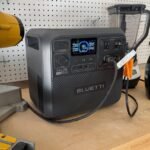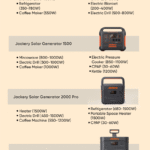Disclosure: This post contains affiliate links and I will be compensated if you make a purchase after clicking through my links. Learn More
To hook up a well pump to a generator, ensure the generator is off, then connect the pump’s power cord. Next, start the generator and test the pump.
Installing a well pump to a generator can be vital during power outages. It ensures a continuous water supply, crucial for daily activities and emergencies. Before starting, gather necessary tools: a generator with sufficient wattage, extension cords, and adapters. Safety is paramount, so read both the pump and generator manuals.
Understanding the power requirements of your well pump is essential. Proper connection prevents damage to both the pump and generator. This guide provides straightforward steps to help you achieve a successful setup, ensuring your water supply remains uninterrupted.
Types Of Generators
Understanding the types of generators is vital when hooking up a well pump to a generator. Different generators serve different needs and capacities. This section explores portable generators and standby generators.
Portable Generators
Portable generators are versatile and easy to move. They are ideal for short-term power needs. You can use them during power outages or for outdoor events. These generators run on gasoline, diesel, or propane.
- Easy to transport
- Affordable
- Suitable for small power needs
Portable generators are simple to operate. Plug your well pump into the generator’s outlet. Ensure the generator’s wattage matches the pump’s requirements.
Standby Generators
Standby generators are fixed units. They provide automatic backup power. These generators are more powerful than portable ones. They can power an entire home, including a well pump.
- Automatic operation
- Higher power output
- Runs on natural gas or propane
Standby generators need professional installation. They connect to your home’s electrical system. When the power goes out, they start automatically. This ensures your well pump keeps running without interruption.
Assessing Power Needs
Before hooking up a well pump to a generator, assess your power needs. Knowing the required wattage ensures you select the right generator. This will prevent power shortages or system overloads. Follow these steps to determine your power requirements accurately.
Calculating Wattage
To calculate the wattage needed, check the well pump’s specifications. Look for the starting and running wattage. Starting wattage is usually higher than running wattage.
Use this formula to determine the total wattage:
Total Wattage = Starting Wattage + Running WattageFor example, if the starting wattage is 2000 watts and the running wattage is 1000 watts:
Total Wattage = 2000W + 1000W = 3000WEnsure your generator can handle this total wattage. A generator with insufficient wattage may damage your well pump.
Choosing The Right Generator
Choose a generator that meets your well pump’s power requirements. Select a generator with a wattage higher than your calculated needs. This ensures safe and efficient operation.
Consider these factors when selecting a generator:
- Fuel Type: Gasoline, diesel, or propane.
- Portability: Wheel-mounted or stationary.
- Noise Level: Decibel rating for quiet operation.
- Runtime: How long the generator can run on a full tank.
Check the generator’s manual for detailed information. Ensure it meets safety standards and has the necessary features for your setup.
A table can help you compare different generators:
| Generator Model | Wattage | Fuel Type | Runtime | Noise Level |
|---|---|---|---|---|
| Wen 56352 | 3500W | Gasoline | 11 hours | 71 dB |
| Honda EG4000 | 4000W | Diesel | 14.8 hours | 67 dB |
| Firman P04001 | 5000W | Propane | 14 hours | 76 dB |
Selecting the right generator is crucial for uninterrupted water supply. Make an informed decision based on your power needs and generator specifications.
Gathering Necessary Tools
Before you start hooking up your well pump to a generator, gather all the necessary tools. This step is crucial. It ensures you have everything you need for a smooth setup. Below are the essential items categorized under basic tools and additional equipment.
Basic Tools Required
- Screwdrivers – Both flathead and Phillips types.
- Wrenches – Adjustable wrenches are highly useful.
- Wire Strippers – For clean and precise wire stripping.
- Electrical Tape – Essential for insulating wires.
- Volt Meter – To measure electrical output.
Additional Equipment
Besides the basic tools, some additional equipment will make the job easier:
| Equipment | Purpose |
|---|---|
| Transfer Switch | Switches power between the generator and the main supply. |
| Extension Cord | Connects the generator to the well pump. |
| Ground Rod | For grounding the generator to prevent electrical hazards. |
| Fuel | Ensures the generator has enough power to run. |
Having these tools and equipment ready will streamline the process. It ensures a safer and more efficient setup.

Preparing The Well Pump
Before connecting your well pump to a generator, prepare the pump correctly. This ensures a safe and efficient process. Follow these steps to get started.
Shutting Off Power
First, turn off the main power supply. Safety is very important. Locate the circuit breaker. Switch it to the “off” position. This prevents any electric shock. Ensure no power flows to the well pump. Double-check with a voltage tester.
Disconnecting Existing Power Source
Next, disconnect the existing power source from the well pump. Find the power cables connected to the pump. Use a screwdriver to remove the connection points. Carefully pull the cables away. Make sure the cables are not touching anything. This step isolates the well pump for generator connection.
| Step | Action |
|---|---|
| 1 | Turn off main power supply |
| 2 | Locate circuit breaker |
| 3 | Switch breaker to “off” |
| 4 | Check with a voltage tester |
| 5 | Disconnect power cables |
| 6 | Remove connection points |
| 7 | Isolate cables |
Following these steps ensures your well pump is ready. Now, you can safely connect it to a generator.
Connecting The Generator
Connecting a generator to a well pump is essential during power outages. You need to ensure the generator provides power to the pump safely and efficiently. This section will guide you through the necessary steps for a seamless connection.
Using Extension Cords
Using extension cords is a simple way to connect the generator. Choose a heavy-duty extension cord for safety. Ensure the cord matches the generator’s power output. Follow these steps:
- Select the correct extension cord. The cord should handle the well pump’s power needs.
- Plug one end into the generator. Make sure the generator is off.
- Connect the other end to the well pump. Ensure the connection is secure.
- Start the generator. Turn on the generator and check the well pump.
Setting Up Transfer Switch
Using a transfer switch is a safer method. It prevents back-feeding and protects utility workers. Follow these steps to set up a transfer switch:
- Install the transfer switch. Place it near the main electrical panel.
- Connect the generator to the transfer switch. Use the provided cables.
- Switch the power source. Turn the transfer switch to the generator position.
- Start the generator. Ensure everything runs smoothly.
Using a transfer switch is more complex but offers better safety. It ensures a seamless power supply to your well pump.
Testing The Setup
Testing the setup is a crucial step in hooking up a well pump to a generator. It ensures the system works efficiently and safely. Follow these steps to check your setup.
Initial Power-on
Before you begin, make sure all connections are secure. Double-check the generator’s fuel and oil levels.
- Turn on the generator and let it run for a few minutes. This helps stabilize the system.
- Switch the well pump’s power supply to the generator. This is usually done through a transfer switch.
- Observe the generator’s performance. Ensure it handles the load without issues.
Checking For Issues
Once the system is running, it’s important to check for any problems. This includes both the generator and the well pump.
- Listen for unusual noises. These could indicate mechanical problems.
- Check for any leaks in the fuel line. Leaks are dangerous and need immediate attention.
- Ensure the well pump is drawing water effectively. Low water flow could signal an issue.
- Monitor the generator’s temperature and voltage levels. They should remain within normal ranges.
If you notice any issues, turn off the system immediately. Troubleshoot the problem before proceeding.
Maintenance Tips
Proper maintenance of your generator is crucial. It ensures smooth operation when you hook up your well pump. This section provides essential maintenance tips. Keep your generator in top shape with these easy steps.
Regular Checks
Perform regular checks on your generator. Look for any signs of wear and tear. Check the oil levels frequently. Ensure the fuel system is clean. Inspect the air filter for dirt and debris. Replace it if needed.
Keep an eye on the battery. Test it to ensure it holds a charge. Examine the spark plugs. Clean or replace them if they appear worn out.
Check the generator’s wiring and connections. Tighten any loose wires. Ensure there are no frayed cables. Regular checks can prevent unexpected breakdowns.
Storing The Generator
Proper storage of the generator is essential. Store it in a dry, cool place. Avoid areas with high humidity. Moisture can damage the internal parts.
Use a cover to protect the generator from dust. Ensure the fuel tank is empty before storing. This prevents fuel degradation.
Disconnect the battery. Store it separately in a cool, dry place. Check on the generator periodically. Run it for a few minutes every month. This keeps the engine parts lubricated.
Frequently Asked Questions
How To Connect A Well Pump To A Generator?
To connect a well pump to a generator, use a transfer switch and follow the manufacturer’s wiring instructions.
What Size Generator For Well Pump?
Determine the generator size based on your well pump’s wattage. Typically, a 5,000-watt generator is sufficient.
Can Generator Damage Well Pump?
Yes, using an improper generator can damage the well pump. Ensure the generator matches the pump’s power requirements.
Do I Need A Transfer Switch?
Yes, a transfer switch safely isolates the well pump from the main electrical grid during generator use.
Final Thoughts
Connecting your well pump to a generator ensures water supply during power outages. Follow these steps for a seamless setup. Always prioritize safety by using the proper tools and guidelines. Regular maintenance of both the generator and the pump is crucial.
With proper care, your well pump will operate efficiently during emergencies.








